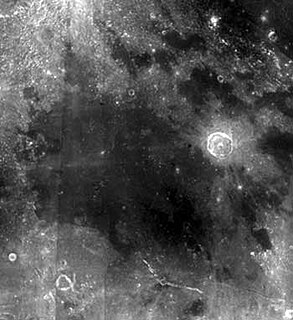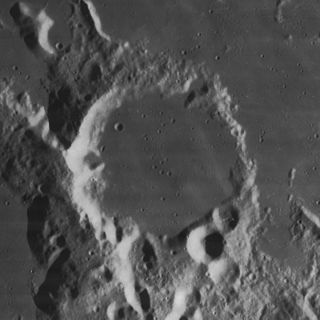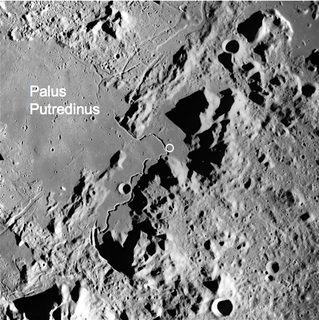
Mare Vaporum is a lunar mare located between the southwest rim of Mare Serenitatis and the southeast rim of Mare Imbrium. It was named by Giovanni Battista Riccioli in 1651.

Montes Haemus is a mountain range that forms the southwestern edge of the Mare Serenitatis basin on the Moon. They form a less prominent mirror image of the Montes Apenninus range to the west, and curve up to nearly join at the northern end. The eastern edge terminates with the Promontorium Archerusia, to the northwest of the crater Plinius. This end reaches a gap where the Mare Serenitatis to the north joins the Mare Tranquillitatis to the south.

Rille is typically used to describe any of the long, narrow depressions in the surface of the Moon that resemble channels. The Latin term is rima, plural rimae. Typically, a rille can be several kilometers wide and hundreds of kilometers in length. However, the term has also been used loosely to describe similar structures on a number of planets in the Solar System, including Mars, Venus, and on a number of moons. All bear a structural resemblance to each other.

Fracastorius is the lava-flooded remnant of an ancient lunar impact crater located at the southern edge of Mare Nectaris. To the northwest of this formation lies the crater Beaumont, while to the northeast is Rosse.

Artsimovich is a small lunar impact crater located in the western Mare Imbrium of the Earth's Moon. This is a circular crater forming a cup-shaped excavation in the surface of the lunar mare. It is named after Soviet physicist Lev A. Artsimovich. To the east is the crater Diophantus and to the northeast lies Delisle. Less than 20 kilometers to the north-northeast is the tiny Fedorov. This crater was identified as Diophantus A before being named by the International Astronomical Union.

Beer is a relatively small lunar impact crater located on the Mare Imbrium, to the east of the crater Timocharis. It was named after German astronomer Wilhelm W. Beer. Just to the northwest is the matching twin Feuillée.

Bode is a small crater located near the central region of the Moon, to the northwest of the joined craters Pallas and Murchison. It lies on a region of raised surface between the Mare Vaporum to the northeast, Sinus Aestuum to the west, and Sinus Medii to the southeast. The crater was named after German astronomer Johann Elert Bode.

Cleomedes is a prominent lunar impact crater located in the northeast part of the visible Moon, to the north of Mare Crisium. It was named after Greek astronomer Cleomedes. It is surrounded by rough ground with multiple crater impacts. The irregular crater Tralles intrudes into the northwest rim. To the east is Delmotte. North of Cleomedes is a triple-crater formation with Burckhardt occupying the center.

Ariadaeus is a small, bowl-shaped lunar impact crater on the western shores of Mare Tranquillitatis. It lies to the north of the crater Dionysius, and to the west-southwest of Arago. The crater is joined along the northeast rim by the slightly smaller Ariadaeus A, and the two form a double-crater. Its diameter is 10.4 km.

Delisle is a small lunar impact crater in the western part of the Mare Imbrium. It was named after French astronomer Joseph-Nicolas Delisle. It lies to the north of the crater Diophantus, and just to the northwest of the ridge designated Mons Delisle. Between Delisle and Diophantus is a sinuous rille named Rima Diophantus, with a diameter of 150 km. To the northeast is another rille designated Rima Delisle, named after this crater.

Diophantus is a lunar impact crater that lies in the southwestern part of the Mare Imbrium. It was named after ancient Greek mathematician Diophantus. It forms a pair with the larger crater Delisle to the north. Diophantus has a wide inner wall and a low central rise. To the north of Diophantus is the sinuous rille designated Rima Diophantus, named after the crater. Diophantus C lies near the exterior of the southwest wall.

Agrippa is a lunar impact crater that is located at the southeast edge of the Mare Vaporum. It is located to the north of the crater Godin, the irregular Tempel lies just to the east. To the north and northeast, the rille designated Rima Ariadaeus follows a course to the east-southeast, reaching the western edge of Mare Tranquillitatis. It is named after the 1st century Greek astronomer Agrippa. Its diameter is 44 km (27 mi).

Calippus is a small lunar impact crater that is located on the eastern edge of the rugged Montes Caucasus mountain range in the northern part of the Moon. It was named after Greek astronomer Callippus of Cyzicus. It lies to the southwest of the crater remnant Alexander, to the northwest of the Mare Serenitatis.

Campanus is a lunar impact crater that is located on the southwestern edge of Mare Nubium. It was named after Italian astronomer Campanus of Novara. It forms a crater pair with Mercator just to the southeast. Along the southern rampart of Campanus is the small lunar mare named Palus Epidemiarum. To the southwest is the small crater Dunthorne.

Capuanus is a lunar impact crater that lies along the southern edge of the Palus Epidemiarum. It was named after Italian astronomer F. Capuano di Manfredonia. The outer rim is eroded and indented by lesser crater impacts, with notches in the north, west, and southern parts of the rim. The interior floor has been resurfaced by basaltic lava, which is connected to the surrounding lunar mare by a narrow, crater-formed gap in the northern rim. Dotting the floor of the crater are a number of domes, which are believed to have formed through volcanic activity.

Sinus Medii is a small lunar mare. It takes its name from its location at the intersection of the Moon's equator and prime meridian; as seen from the Earth, this feature is located in the central part of the Moon's near side, and it is the point closest to the Earth. From this spot the Earth would always appear directly overhead, although the planet's position would vary slightly due to libration.

Mons Bradley is a lunar mountain massif in the Montes Apenninus range, along the eastern edge of the Mare Imbrium. It is located to the west of the crater Conon. To the west of this peak is the Rima Bradley rille.

Palus Epidemiarum is a small lunar mare in the southwestern part of the Moon's near side. This feature forms a rough band of lava-flooded terrain that runs generally west–east, with a northward extension near the western end. It spans a shallow trough extending 300 by 120 km. The average thickness of the basalt is 200–250 m, with a maximum depth of 750 m. The feature lies to the southwest of Mare Nubium, and southeast of Mare Humorum.

Palus Putredinis is a small lunar mare in the basin of Mare Imbrium. It stretches from the crater Archimedes southeast toward the rugged Montes Apenninus range located on the southeastern edge of Mare Imbrium. This region is a nearly level, lava-flooded plain bounded by the crater Autolycus and nearby highlands to the northeast and the foothills of the Montes Archimedes to the southwest. The selenographic coordinates are 27.4° N, 0.0° E, and it lies within a diameter of 180 km.

Hadley–Apennine is a region on the near side of Earth's Moon that served as the landing site for the American Apollo 15 mission, the fourth manned landing on the Moon and the first of the "J-missions", in July 1971. The site is located on the eastern edge of Mare Imbrium on a lava plain known as Palus Putredinis. Hadley–Apennine is bordered by the Montes Apenninus, a mountain range, and Hadley Rille, a meandering channel, on the east and west, respectively.





















